A new input stage daughter card for M2x: Cedarburg / IPS8 (Jan 2021)
I present here the eighth input stage daughter card design for M2x power amplifiers: Cedarburg.
The design goal was simple: build an M2x input stage using the legendary / formidable/ recondite AD797 opamp from Analog Devices. This 29-year-old chip is both highly regarded, and greatly feared, in the audio design community: it offers tremendous performance, but is notoriously difficult to stabilize. Lots of very talented engineers have tried, unsuccessfully, to build a Jung/Didden "Super Regulator" with the AD797; they all found that it oscillated instead of amplified. Even Walt Jung himself (an employee of Analog Devices!), finally threw in the towel and instead recommended the AD825 for Super Regulators.
The Cedarburg circuit unveiled here does not oscillate, thanks to the use of Input Compensation: R11,R12,C5. (See Chapter 13, "Compensation Revisited", in the MIT Open Courseware documentation), and also thanks to a relatively elaborate power supply bypassing arrangement. Like all the other M2x input stage daughter cards, Cedarburg functions as a unity gain buffer and current booster, to drive the low impedance primary of the interstage transformer on the M2x amplifier PCB.
WARNING: Cedarburg is not a suitable project for beginners or builders who want instructional videos, step by step photographic Build Guides, or training wheels style tutorials. If you think you need more than a schematic, parts list, and PCB CAD manufacturing file ("Gerber"), Cedarburg is probably not for you. Build other projects first, gain more experience, and expand your capabilities. Then, after you have become an Advanced Skills builder, take on the Cedarburg challenge. But not before.
CAUTION: Cedarburg uses the AD797 chip, which is expensive. Vacuum tube expensive. Check AD797 prices at your favorite distributor (or use octopart.com) and decide whether you want to spend that much money (times two for a stereo M2x) on IPS cards. Admittedly, an IPS which vanquishes the unconquerable AD797.
POWER SUPPLY AND BYPASS
More than half of the components on the Cedarburg PCB are dedicated to power supply management and bypassing. This is because the AD797 is "twitchy" and needs wideband, very low impedance supplies.
D1, Q1, and Q2 regulate the supply voltage (VUPPER - VLOWER), setting it to (30V - 2*VBE), which is comfortably below the AD797's Absolute Maximum Rating of 36V. Bleeder resistors R1 and R6-7 discharge the internal supplies when the amp is turned off; they also establish minimum bias currents during normal operation.
Internal supplies are bypassed by the parallel combination of C2 + C3 + C4, and capacitor self-resonances are damped by R8 and R9. Jerald Graeme of Burr-Brown wrote a book called Optimizing Op Amp Performance which devotes an entire chapter (pp. 73-102) to this phenomenon. One of his Figures is copied below.
These measures appear to have been successful; Cedarburg exhibits no power supply induced oscillation, at least, not in my lab tests.
DOCUMENTATION
A zip archive of the PCB manufacturing files in Gerber format, is attached below. Also attached are a detailed Parts List and a circuit schematic diagram as a .pdf document.
ABOUT THE NAME
The AD797 opamp was designed by Scott Wurcer, who is also an active member here on diyAudio. I sent Scott the schematics and asked him to suggest a city to be used as the name of this PCB. He chose Cedarburg, a town in his boyhood state of Wisconsin. Done!
_
I present here the eighth input stage daughter card design for M2x power amplifiers: Cedarburg.
The design goal was simple: build an M2x input stage using the legendary / formidable/ recondite AD797 opamp from Analog Devices. This 29-year-old chip is both highly regarded, and greatly feared, in the audio design community: it offers tremendous performance, but is notoriously difficult to stabilize. Lots of very talented engineers have tried, unsuccessfully, to build a Jung/Didden "Super Regulator" with the AD797; they all found that it oscillated instead of amplified. Even Walt Jung himself (an employee of Analog Devices!), finally threw in the towel and instead recommended the AD825 for Super Regulators.
The Cedarburg circuit unveiled here does not oscillate, thanks to the use of Input Compensation: R11,R12,C5. (See Chapter 13, "Compensation Revisited", in the MIT Open Courseware documentation), and also thanks to a relatively elaborate power supply bypassing arrangement. Like all the other M2x input stage daughter cards, Cedarburg functions as a unity gain buffer and current booster, to drive the low impedance primary of the interstage transformer on the M2x amplifier PCB.
WARNING: Cedarburg is not a suitable project for beginners or builders who want instructional videos, step by step photographic Build Guides, or training wheels style tutorials. If you think you need more than a schematic, parts list, and PCB CAD manufacturing file ("Gerber"), Cedarburg is probably not for you. Build other projects first, gain more experience, and expand your capabilities. Then, after you have become an Advanced Skills builder, take on the Cedarburg challenge. But not before.
CAUTION: Cedarburg uses the AD797 chip, which is expensive. Vacuum tube expensive. Check AD797 prices at your favorite distributor (or use octopart.com) and decide whether you want to spend that much money (times two for a stereo M2x) on IPS cards. Admittedly, an IPS which vanquishes the unconquerable AD797.
POWER SUPPLY AND BYPASS
More than half of the components on the Cedarburg PCB are dedicated to power supply management and bypassing. This is because the AD797 is "twitchy" and needs wideband, very low impedance supplies.
D1, Q1, and Q2 regulate the supply voltage (VUPPER - VLOWER), setting it to (30V - 2*VBE), which is comfortably below the AD797's Absolute Maximum Rating of 36V. Bleeder resistors R1 and R6-7 discharge the internal supplies when the amp is turned off; they also establish minimum bias currents during normal operation.
Internal supplies are bypassed by the parallel combination of C2 + C3 + C4, and capacitor self-resonances are damped by R8 and R9. Jerald Graeme of Burr-Brown wrote a book called Optimizing Op Amp Performance which devotes an entire chapter (pp. 73-102) to this phenomenon. One of his Figures is copied below.
These measures appear to have been successful; Cedarburg exhibits no power supply induced oscillation, at least, not in my lab tests.
DOCUMENTATION
A zip archive of the PCB manufacturing files in Gerber format, is attached below. Also attached are a detailed Parts List and a circuit schematic diagram as a .pdf document.
ABOUT THE NAME
The AD797 opamp was designed by Scott Wurcer, who is also an active member here on diyAudio. I sent Scott the schematics and asked him to suggest a city to be used as the name of this PCB. He chose Cedarburg, a town in his boyhood state of Wisconsin. Done!
_
Attachments
-
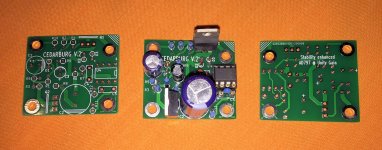 CB_photo1.JPG378.6 KB · Views: 753
CB_photo1.JPG378.6 KB · Views: 753 -
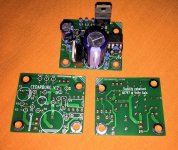 CB_photo2.JPG574.1 KB · Views: 14,701
CB_photo2.JPG574.1 KB · Views: 14,701 -
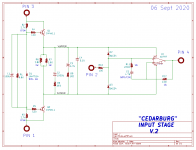 cbsch.png14 KB · Views: 14,670
cbsch.png14 KB · Views: 14,670 -
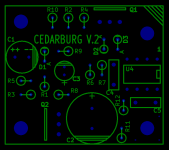 silkscreen.png21.6 KB · Views: 2,137
silkscreen.png21.6 KB · Views: 2,137 -
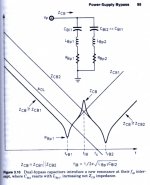 Graeme.jpg138.9 KB · Views: 978
Graeme.jpg138.9 KB · Views: 978 -
Schematic_CB.pdf19.5 KB · Views: 325
-
M2_ips_Cedarburg_rev2_Gerbers.zip12.5 KB · Views: 254
-
Parts_List_Cedarburg.zip6 KB · Views: 346
Thanks Mark! Looks great. Time to organize a GB for the boards....I need four so I may be willing to order boards.
Mouser has the AD797 listed for $13.31 which is pricey for a chip op amp but a lot less than builders are paying for discreet op amps like the Bursons etc.
https://www.mouser.com/ProductDetai...JOCCsySE6VLy/kBS1Y85lleDbIZYVBLOG8jEQGXHC3w==
Mouser has the AD797 listed for $13.31 which is pricey for a chip op amp but a lot less than builders are paying for discreet op amps like the Bursons etc.
https://www.mouser.com/ProductDetai...JOCCsySE6VLy/kBS1Y85lleDbIZYVBLOG8jEQGXHC3w==
Congratulations Mark 
My apology in advance for the off topic and naive question, but would your AD797 topology be a suitable basis for a phono stage as well?

My apology in advance for the off topic and naive question, but would your AD797 topology be a suitable basis for a phono stage as well?
That was intended to be a no, hence the link to an existing (and fantastic) AD797 phono.
😀 😀 😀
😀 😀 😀
Yeah, I also wondered I could use Tucson or IPS7 for a few AD797 and OPA627 laying around. I guess not.
Mark, if you want to play with the OPA627 but don't have them, let me know, I can send a couple to you.
Thanks!!
Mark, if you want to play with the OPA627 but don't have them, let me know, I can send a couple to you.
Thanks!!
Thanks Mark! It's nice to have this option. 🙂AD797 is a neat part, I’m really looking forward to this!!!!!!
Regards,
Dan
So I will ask the question, is the Cedarburg a more better Tucson, or IPS7?
I guess I’ll find out when I build one. I’m assuming it will support less finicky OpAmps?
I guess I’ll find out when I build one. I’m assuming it will support less finicky OpAmps?
I guess OPA 1611 is not a problem on IPS?
Better i ask then to blow up the amp...(that I have not bought yet,from diyaudio store)
Better i ask then to blow up the amp...(that I have not bought yet,from diyaudio store)
I had AD797 on my list to try out on IPS7. There is layout for a compensation capacitor. Maybe the datasheet for AD797 should be investigated and check for "unity gain stability"?
I guess my question really simplifies down to: Will Cedarburg work with the other less finicky single OpAmps in a DIP8 package? And, being better regulated than the other 2 OpAmp boards, will it be better with these other OpAmps?
Last one (for now!). Will we be making an adapter to use these cards with the fabled Simple Sit amp? Not that you can tell us anything now, I understand. It would be way cool to be able to use this growing stable of input cards...
Last one (for now!). Will we be making an adapter to use these cards with the fabled Simple Sit amp? Not that you can tell us anything now, I understand. It would be way cool to be able to use this growing stable of input cards...
- Home
- Amplifiers
- Pass Labs
- The diyAudio First Watt M2x